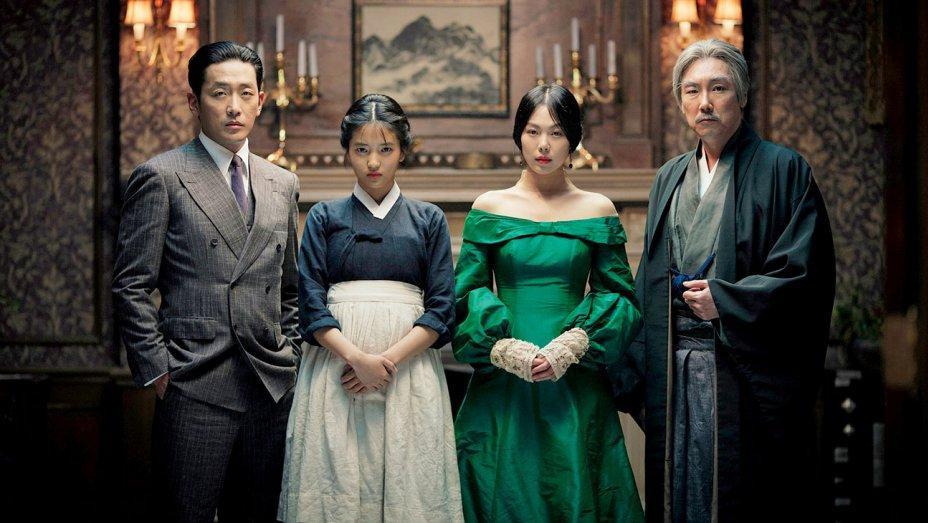The Handmaiden (2016) is a South Korean erotic thriller, directed by the talented Park Chan-wook. Set in Korea during its period of occupation by the Japanese, the film follows Lady Hideko and her relations with her maid Sookee, her uncle Kouzuki, and her suitor Fujiwara. Divided into three arcs, the film follows a non-linear timeline. The film is a visual delight because of its opulent sets, period costumes, and skilful camerawork.
The Handmaiden is spearheaded by two female leads, a rarity in South Korean cinema. Actresses Kim Min-hee (Hideko) and Kim Tae-ri (Sookee) have been known to take on risky projects and their decision to star in The Handmaiden definitely paid off in terms of the accolades they received received personally and as an ensemble. The film was also nominated for the Palme d’Or at the Cannes Film Festival. Director Park Chan-wook spins his magic once again after his magnum opus Oldboy. The fragility of the subject, its historical background and brilliant cinematography is enhanced by mysterious characters in vintage clothing.
The Handmaiden has no intention of being a feminist cinematic experience. But its handling of subjects such as female sexuality, domestic abuse and the normative behaviours of women brings it to the cusp of becoming one. It’s jarring plot line focuses more on the contestations between equally jarring characters. The scheming is individualistic but the power wielded by certain characters is definitely gendered. The uncle and the suitor are two characters who construct the framework of the film with the two female protagonists circumventing them.
The Handmaiden has no intention of being a feminist cinematic experience.
The context of Japanese culture uplifts The Handmaiden’s dialogue between the lives of men and women. The expectations from Japanese women greatly diverge from those of the West. The perfection that these women were obligated to exude was stifling to say the least. From the intricate tea ceremonies conducted only by women to their manner of speaking, The Handmaiden has captured what it meant to be a woman in Korea during the Japanese occupation. The imposition of Japanese culture onto an already orthodox Korean culture, creates an atmosphere of suffocating femininity.
The Handmaiden’s nuanced representation of women’s sexuality made the explicit content strewn across it not appear as vulgar or unnecessary. Hideko’s concerns at the prospect of her first time with a man not being enjoyable are quelled by Sookee as she makes love to her. It is a sexual transaction without any feelings involved. This was a departure from the usual portrayal of lesbian encounters. The emotionality of women ceases to be central here. Instead it’s a purely bodily pleasure. The sexual overtones were not aimed at the male gaze but are a successful insight into the pleasures that women enjoy and how they experience them. I would go as far as to call the sexual experience liberating for the them.
Both Fujiwara and Kouzuki think that Hideko and Sookee are gullible (like ‘all’ women) and won’t be able to see through their conniving schemes. They consider themselves impervious to being caught for their victims are easy pickings and in relatively weaker positions. Despite these underlying assumptions, the film subverts the meanings of weakness and strength along with those femininity and masculinity. The fragile and delicate Hideko, clad in her gossamer gowns, hatches a masterplan to free herself from the clutches of her uncle without losing her inheritance. She eventually falls in love with Sookee and they escape together.
Also Read: Not Your Culture-Why Cultural Appropriation Needs to Stop
Tim Robert from The Telegraph calls the movie an antique sudoku. That is precisely what it is aiming to be as well. Like every competent thriller, The Handmaiden keeps the audience on its toes. One must not be taken in by the blatant eroticism portrayed in it. It is merely a plot device (that is rendered beautifully) and not pornographic.
Uncle Kouzuki and Hideko’s aunt have a highly dysfunctional relationship and the latter is unhappy in their marriage. She runs away but is later found hanging from a tree within the house. Physical abuse is not alluded to although psychological trauma is a part of the dynamic between the couple. Kouzuki has a basement full of sadistic pornographic books that he forces his wife to read in front of prospective buyers and collectors. Her consent is not taken into consideration and neither is the inappropriateness or intimacy it the act. On his wife’s death, he trains Hideko to also indulge in the same. His paraphilia breeds terror for the women in his household but his large estate and close associations with the Japanese imperialists make him untouchable.
His paraphilia breeds terror for the women in his household but his large estate and close associations with the Japanese imperialists make him untouchable.
Kim Min-hee as Hideko is a force to be reckoned with. The illusion of her delicate femininity gives way to a cunning woman who knows how see through people. Kim Tae-ri on the other hand, although outshone by the other Kim, owns the screen with her docile servitude. She is not the centre of our attention but is pivotal to the plot. If the lack of emotionality is the film’s strength, it can also be construed as its shortcomings. The characters appear two-dimensional at times, with not enough development. The growth of the characters gets lost in the depth of the plot. Nevertheless, The Handmaiden takes one on an unparalleled cinematic journey that is replete with history, sex and revenge.
Featured Image Source: Hollywoodreporter
About the author(s)
Divya Godbole is a Sociology Honours student, interested in understanding how personal troubles turn into public issues. But she finds solace from these existential questions in K-pop, cats and Pride and Prejudice.




